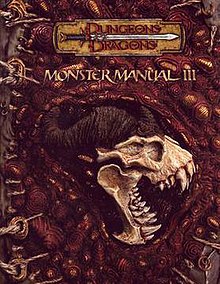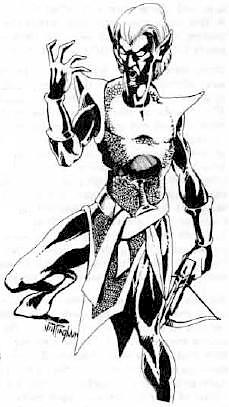
The drow or dark elves are a dark-skinned and white-haired subrace of elves connected to the subterranean Underdark in the Dungeons & Dragons fantasy roleplaying game. The drow have traditionally been portrayed as generally evil and connected to the evil spider goddess Lolth. However, later editions of Dungeons & Dragons have moved away from this portrayal and preassigned alignment. More recent publications have explored drow societies unconnected to Lolth.

The Monster Manual is the primary bestiary sourcebook for monsters in the Dungeons & Dragons fantasy role-playing game, first published in 1977 by TSR. The Monster Manual was the first hardcover D&D book and includes monsters derived from mythology and folklore, as well as creatures created specifically for D&D. Creature descriptions include game-specific statistics, a brief description of its habits and habitats, and typically an image of the creature. Along with the Player's Handbook and Dungeon Master's Guide, the Monster Manual is one of the three "core rulebooks" in most editions of the D&D game. As such, new editions of the Monster Manual have been released for each edition of D&D. Due to the level of detail and illustration included in the 1977 release, the book was cited as a pivotal example of a new style of wargame books. Future editions would draw on various sources and act as a compendium of published monsters.
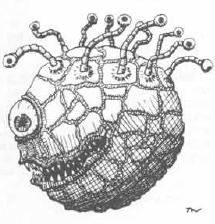
The beholder is a fictional monster in the Dungeons & Dragons fantasy role-playing game. It is depicted as a floating orb of flesh with a large mouth, single central eye, and many smaller eyestalks on top with powerful magical abilities.
In the fantasy role-playing game Dungeons & Dragons, an Outer Plane is one of a number of general types of planes of existence. They can also be referred to as godly planes, spiritual planes, or divine planes. The Outer Planes are home to beings such as deities and their servants such as demons, celestials and devils. Each Outer Plane is usually the physical manifestation of a particular moral and ethical alignment and the entities that dwell there often embody the traits related to that alignment.
The Underdark is a fictional setting which has appeared in Dungeons & Dragons role-playing campaigns and Dungeons & Dragons-based fiction books, including the Legend of Drizzt series by R. A. Salvatore. It is described as a vast subterranean network of interconnected caverns and tunnels, stretching beneath entire continents and forming an underworld for surface settings. Polygon called it "one of D&D's most well-known realms".

The planes of the Dungeons & Dragons roleplaying game constitute the multiverse in which the game takes place. Each plane is a universe with its own rules with regard to gravity, geography, magic and morality. There have been various official cosmologies over the course of the different editions of the game; these cosmologies describe the structure of the standard Dungeons & Dragons multiverse.

The Manual of the Planes is a manual for the Dungeons & Dragons role-playing game. This text addresses the planar cosmology of the game universe.
The warforged are one of the playable fictional races of creatures in the Eberron campaign setting of the Dungeons & Dragons fantasy role-playing game.

Eberron Campaign Setting is a hardcover accessory for the 3.5 edition of the Dungeons & Dragons fantasy role-playing game.
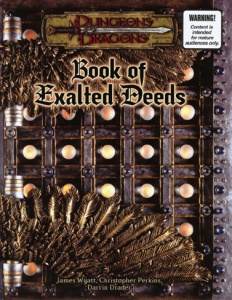
The Book of Exalted Deeds is an optional sourcebook for the 3.0 edition of the Dungeons & Dragons role-playing game published by Wizards of the Coast (WotC) in 2003. It provides supplementary game material for campaigns involving characters of good alignment. Within the game, there is also a powerful magical artifact of the same name.

Tiamat is a supremely strong and powerful 5-headed draconic goddess in the Dungeons & Dragons role-playing game. The name is taken from Tiamat, a goddess in ancient Mesopotamian mythology. She is the queen and mother of evil dragons and a member of the default pantheon of Dungeons & Dragons gods. Her symbol is a five-headed dragon.

James Wyatt is a game designer and a former United Methodist minister. He works for Wizards of the Coast, where he has designed supplements and adventures for the Dungeons & Dragons (D&D) roleplaying game. He is the author of sci-fi and fantasy novels, including Forgotten Realms books, and the 4th edition Dungeon Master's Guide.

In the Dungeons & Dragons role-playing game, orcs are a primitive race of savage, bestial, barbaric humanoid.

The lich is an undead creature found in the Dungeons & Dragons (D&D) fantasy role-playing game. Liches are spellcasters who seek to defy death by magical means.
David Noonan is an author of several products and articles for the Dungeons & Dragons fantasy role-playing game from Wizards of the Coast.

Monstrous Compendium: Monsters of Faerûn is a supplement for the 3rd edition of Dungeons & Dragons.
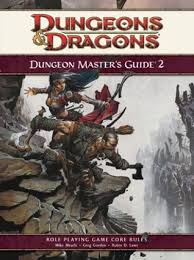
Dungeon Master's Guide 2 is a supplement to the 4th edition of the Dungeons & Dragons role-playing game.

Monster Manual 2 is a supplement to the 4th edition of the Dungeons & Dragons role-playing game.
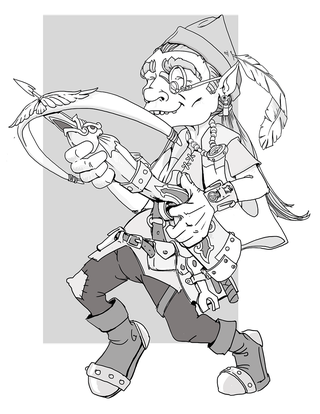
In the Dungeons & Dragons fantasy role-playing game, gnomes are one of the core races available for play as player characters. Some speculate that they are closely related to dwarves; however, gnomes are smaller and more tolerant of other races, nature, and magic. Depending on the setting and subrace, they are often skilled with illusion magic or engineering. Gnomes are small humanoids, standing 3–3.5 feet (91–107 cm) tall.
